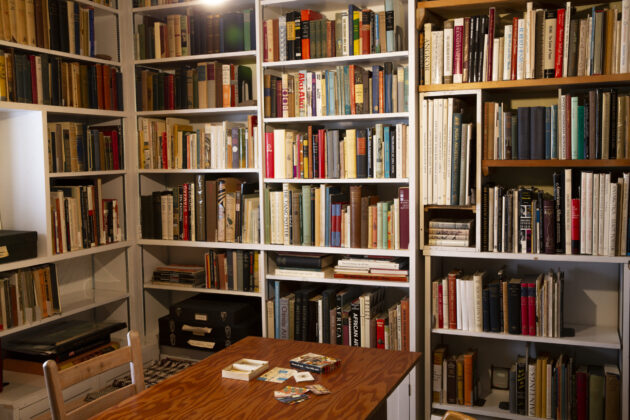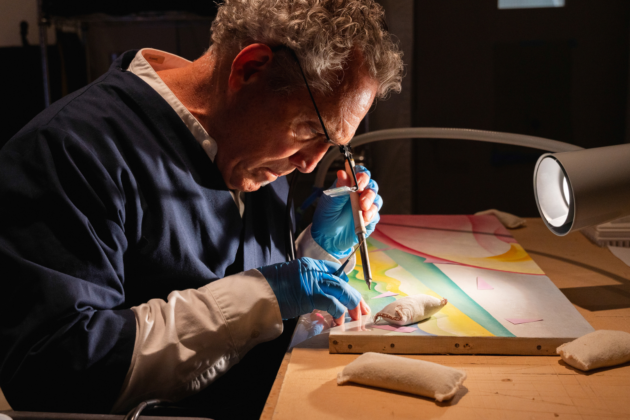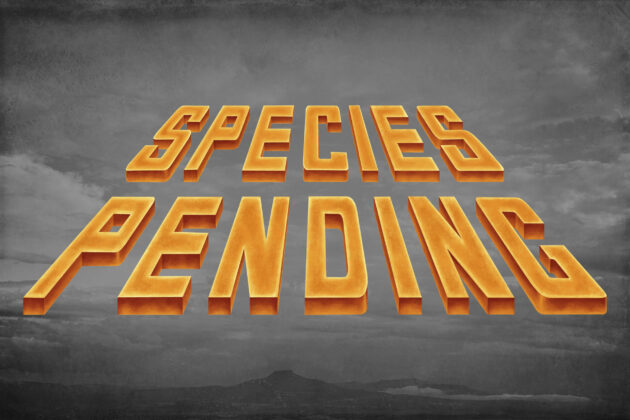
Part II: 1943/1968 – What They Saw
“Miss O’Keeffe’s Bones,” or What Became of Them[1]
I started my expedition by searching through the museum’s archive of critical writing and literature about O’Keeffe—a collection meticulously accumulated and organized by former Georgia O’Keeffe Museum curator, Barbara Buhler Lynes. The files now live in the institution’s fantastic Research Center, where I spend my days enthralled by the decades of writing contained in a single file drawer at the bottom of a rolling compression shelf. Cody and I were looking for major exposés published during her lifetime—things that could sit in a gallery to enhance a visitor’s understanding of O’Keeffe’s reputation from a more historical, contextualized vantage point. Perhaps, we thought, these examples could speak to the question of, “where did Georgia O’Keeffe sit in public discourse?” There is one such feature in the June 1943 issue of American Artists. On the cover, a Stieglitz photograph introduces a pensive, striking O’Keeffe, who peers out the window of her automobile, resting her head almost awkwardly on the backside of her hand, which splays across the ledge of the window frame. Inside, an image of her White Petunia with Salvia, No. 3 prefaces an enthusiastic article by Ernest W. Watson, a regionalist artist and advocate of American art (and an acquaintance of O’Keeffe), where he proclaims O’Keeffe’s brilliance on the auspices of her indefinable originality, born by her adventurous, independent spirit. Watson focuses largely on her biography, positioning her art as extremely personal and a product of what she sees in her daily life. He seeks to demystify her pictures, releasing them from the corner of too “difficult to understand”—a space that both she and her work inhabited for much of her early career. Her approach, most inspired by her teacher Arthur Dow, is rooted in the closest mode of looking, magnifying the miniscule into the massive so that the spectator becomes the butterfly playing in the sex of the flower.[2] But most importantly—and I think what withstands most over time—is Watson’s intuitive constitution of O’Keeffe’s independence as a person, her characteristic style, and her almost aloof removal from the scene in New York City as mutual, component parts. Her way of seeing, transcribed onto her canvases, is integral to her personal independence: her unique perception is a radical reshaping of sight, diverging from tradition, and a true approach of freedom. The role of the artist as a seer—an individual who translates nature into pleasing design, and in doing so liberates herself from constraints of tradition—is central for Watson, and so the artists takes on the role of a leader, providing for their spectator a mode of looking that evokes pleasure and prompts similar approaches to life.
Twenty-four years later, in March of 1967, Vogue featured original photographs by Cecil Beaton of O’Keeffe at her home in Abiquiu for a large spread on her life and work. E.C. Goossen, the article’s author and a well known academic, was organizing an exhibition for The Museum of Modern Art, involving what we now know as Minimalist, Color Field, and Abstract Expressionist artists. Titled The Art of the Real, O’Keeffe plays a central, generative role in this show: Goossen understood her to represent the first truly modern American artist, “prophetic” of the apotheosis of American modernism, being the 1950s and ‘60s. He identifies her as the first American to master paring her pictures so far down that they became a flat composition of colors, radically opposing herself to “realism,” for the sake of “the real.”[3] In her images, content does not evoke feeling. Rather, the content is a feeling. In Goossen’s 1968 exhibition, O’Keeffe’s influence pervades the world’s art capital, as she reigns over Robert Smithson, Jackson Pollock, Barnett Newman, Jasper Johns, and Ellsworth Kelly, among others. The two paintings by O’Keeffe that feature in the show, Blue Lines Number 10 (1916) and Lake George Window (1929), are the earliest works on the checklist, and sit at the very front of its catalogue. In the Vogue article from the previous year, where O’Keeffe poses dramatically austere in a series of three outfits, you can tell Goossen was organizing The Art of the Real. He martials his reader through her career, limning her as the true progenitor of contemporary American Modernism, the original Romantic and precursor to Abstract Expressionism. In his own words, her name is “engraved on the cornerstone of modern American art… As time goes on that name looms larger and larger.”[4] Not unlike Watson’s assessment, she is unique, and her art intimately connected with her own sense of individualism—an aspect defined by her perception of things, which refuses “realism” in favor of rigorous and liberated expression. But with two additional decades on his side, Goossen is eager to push against the essentializing, gendered framework that he argues overshadowed her early career, and he manages to do so without totally disavowing the importance of sensitivity and emotion in her pictures. The canvas remains a sensual extension of her mind and her encounters with nature, but it is indicative of intellect, rather than the perceived and supposedly inherent characteristics of a woman.
From the early part of the twentieth century through the 1960s, the reception of O’Keeffe’s art remains consistently positive and, explicitly gendered or not, invested in the intensely personal, emotive qualities that render her pictures entirely original. Mindful of this consistency in her work’s reception, not to mention the consistency in her actual art, which remains astoundingly uniform in style over the course of her career, we may perhaps draw interesting conclusions about the ways the criticism of her work does change, fitted to the changing attitudes towards modern art. You can, it feels, read the files accumulated by Barbara Lynes as if peering into an arena of the shifting field of American modernism. Early psychoanalytic readings brought O’Keeffe’s gender to the fore, but then critics lost interest in gender, taking surrealist delight in the anthropomorphism of her blown-up plants. Voices most invested in the notion of American Modernism lauded her application of abstraction to distinctly “American” subject matter, obsessing over her pristine technique, and finally, pundits in the ‘60s began to find language to consider her Romantic, emotional way of engaging the world, a technique they felt permitted the spectator to become enveloped in the feeling embodied by her pictures.
This post was written by Thomas Edwards, Curatorial Intern, Marsh Family Fellow.
The feature image is a group of magazine and newspaper features composited by the author, including American Artist (June 1943), Town and Country (January 1943), House Beautiful (April 1963), and Vogue 149 (March 1, 1967).
[1] The quoted portion of this title is taken from Henry McBride’s review of O’Keeffe’s show at An American Place, which appeared in The New York Sun, January 18th, 1944.
[2] Ernest W. Watson, “Georgia O’Keeffe,” American Artist, June 1943, 7, 11.
[3] E.C. Goossen, The Art Of the Real (New York: Musuem of Modern Art, 1968), 7.
[4] Goossen, “O’Keeffe,” Vogue, March 1, 1967.


